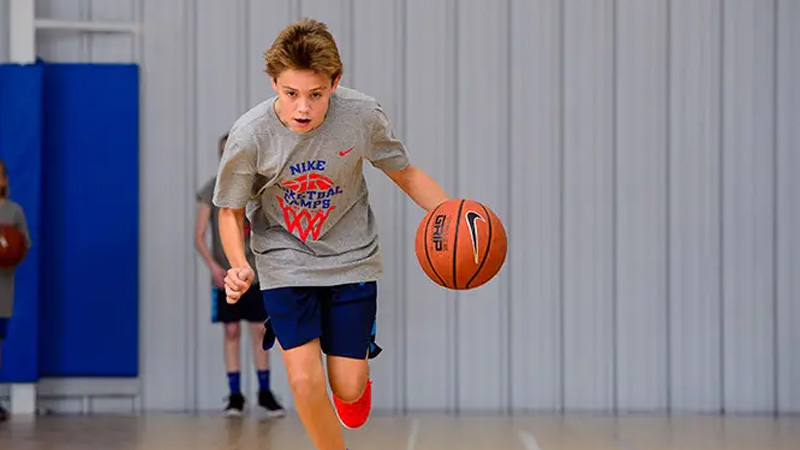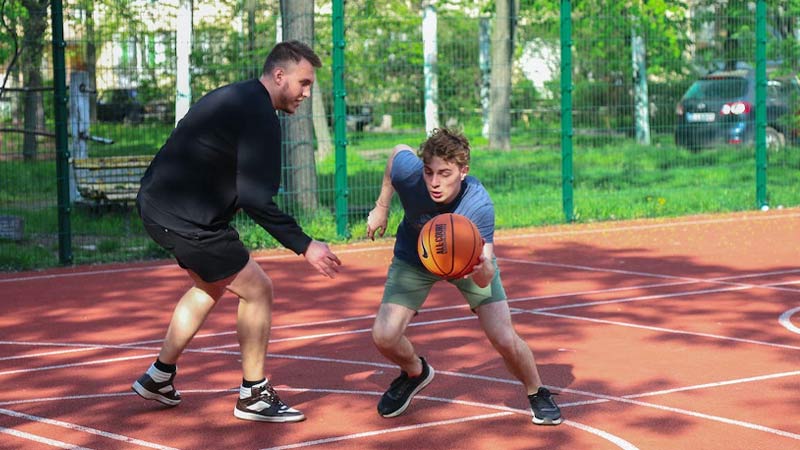Time to brainstorm your ideas with Basketball!
Basketball has been a popular and worldwide familiar sport. Originally, invented as an indoor sport, Baseball is now not limited to your backyard anymore.
Before you go and shout out loud in the field of Basketball, it is a must to know the basics of this popular sport – especially the rules, court, and player position.
Today, we will look at Basketball from a beginner’s perspective. By the end of this article, you will be fully prepared to enjoy the sport.
Basketball Basics for Beginners
So, how do you play basketball? Here’s a quick pick for you:
In this game, players work together as a team. There are two hoops and respective teams have to get the basketball through the hoop of the offense before the opposing team does the same and scores.
It may seem like a simple equation; but not before you get into the details.
Before we start, here is a list of terminology that you should know.
| Backboard: It is a rectangular or fan-shaped structure that is positioned vertically behind the basket. |
| Air Ball: A shot, in Basketball, that misses the rim or backboard. |
| Rim: It is a metal hoop attached to the backboard; a circular in shape and serves as the target. |
| Assist: It is a pass to a teammate that immediately scores a basket. |
| Fast break: An action taken by the offensive team when they move the ball quickly down the court to move ahead of the defense team. |
| Rebound: When a player grabs the ball after a missed shot, it is called a rebound. Players have two types of rebounds in the field.
Offensive Rebounds: When a player grabs a missed shot from his team. Defensive Rebounds: It is about grabbing a missing shot from the opponent. |
| Foul: Specific actions by players that break the rules but not floor violations. The team who makes a foul will be penalized with a free possession of the ball or a free throw. |
| Jump ball: It is a way to start a basketball match. During a Jump ball, two opponent players jump in the air to tap the ball to their teammates. |
| Shot Clock: As the name suggests, the shot clock is a timer. It limits the amount of time a team takes to attempt a shot. |
| Three-pointer: It is a shot taken from beyond the three-point line. Upon a successful shot, three points are made. |
| Court: It is the surface where players perform. A basketball court is a rectangular area with specific markings and dimensions. |
| Free Throw: After a foul is committed, the opposing team is awarded free throws. The opponents have to go from the marked free-throw line (ranging 10-15 feet from the basket) where the rest of the players line up down the key. |
| Double dribble: It is an act when a player dribbles the ball with two hands simultaneously or picks up their dribble and then dribbles again without passing or shooting. |
| Zone Defense: In a zone defense, players are assigned specific areas or zones on the court to guard rather than guarding specific opponents. |
| Pick-and-roll: It is a common offensive play where a player sets a screen (pick) for a teammate handling the ball. |
| Turnover: When the offensive team fails to dominate the ball without even attempting a shot, it’s a turnover. It can happen due to a steal by the defense, an offensive foul, traveling, or stepping out of bounds. |
| Tip-off: It is the initial Jump Ball to start the basketball match. |
Rules of Basketball

Source: realhoopers.com
Basketball is a team sport. Two teams have five players in total performing the match. The game is organized and well-formed with two sets of rules different for offensive and defensive teams. Described below:
Basketball Rules for Offensive Team
The team with basketball is called the team on offense. When a player owns a basketball, he must follow certain rules. They are:
1) Dribble The Ball
The player has the ball and thus he must bounce or dribble the ball with one hand while moving both feet.
However, he will be restricted to one foot at once his both hands touch the basketball or he stops dribbling. The still foot is the Pivot foot.
2) One-Turn Dribble Only
Dribbling is available for players at only one turn. To put it simply, when a player stops dribbling, he can’t start to dribble again.
Keep in mind that double dribbling is not allowed in basketball. Any player who commits double dribbling will lose the basketball to the opposing team.
However, double dribbling is allowed only if another player from the offensive or defensive team touches or takes control of the ball; usually after a successful shot or pass.
3) Ball in Bounds
The offensive team must keep the ball in their bounds. However, if the ball, in any event, gets out of the offensive bounds, the ball will directly be in control of the other team.
4) Don’t Touch the Bottom
This one is for the dribbling player. While dribbling, his hands must remain on top of the basketball.
If a player touches the bottom of the ball while dribbling, it will not be dribbling anymore. Rather, it will be called carrying the ball.
And if a player continues to dribble like this, he will lose the ball to the other team.
5) Don’t Return to Backcourt
This is a tug of war! When the offensive team passes the half-court, they can’t return to the backcourt. This is a strict violation.
However, the offense can legally recover the ball from the backcourt when the defensive team throws the ball into the backcourt.
The offensive team must follow these rules while they have the ball in possession. But what about the defensive team? No guideline for them? Yes! There are. Keep reading.
Basketball Rules for Defensive Team

Source: sportsrec.com
Of the two teams, the one without basketball is the defensive team. The number of rule lists is very limited though. Here it is,
1) No Foul
The major rule for the defensive team is not to make a foul. In Basketball, the field referee is quite straightforward about setting up foul rules.
However, by any means, defensive players shouldn’t touch or make any contact with any offensive player; especially not with the intention to cause the offensive player to lose the ball or miss any shot.
When the ball is not in possession of any team, not many rules are applied to that team. They only need to follow one thing strictly i.e. do not commit any unfair act that prevents the offensive teammate from their genuine success.
Is this all?
So far, both offensive and defensive have to follow these rules while in and without possession of the basketball. But, that’s not all.
Some rules also apply to the rest of the players. As a beginner, you should be aware of the general rules:
- Fouls apply to every player on the court including the offensive ones.
- Players can’t use their fists to hit the ball or kick it.
- Players are prohibited from touching the ball when it is going downward to the basket. Or, in case the ball is in the rim. It is called goaltending. However, touching the ball on the rim is legal in some matches.
Regardless of the position they play on the court, every player is bound by the same rules. Remember that, there are no positions in basketball’s rules; instead, the positions are used only for team strategy.
Positions in Basketball
In Basketball, positions are used for forming team strategy rather than building a lineup. But players’ position in basketball is not something to be ignored.
There are five positions on the court of basketball. Here’s a brief explanation of players’ positions.
Point Guard (PG)
It is the most crucial point in basketball. Typically, the team’s primary ball-handler and playmaker take up this position. They are responsible for directing the team’s offense, setting up plays, and facilitating scoring opportunities for their teammates.
It is expected of the point guard players that they have extraordinary dribbling and passing skill. Usually, they are the ones with the ball in their hands and run the offense.
Shooting Guard (SG)
Another important position is the basketball court. They are best known for their scoring ability and perimeter shooting. They are experts at shooting from mid-range and beyond the three-point line.
Besides, they must also be efficient at dribbling for an additional hand to the point guard. If they have other skills like catch-and-shoot jumpers, pull-up jump shots, and the ability to create their shot off the dribble – then that’s a plus point.
Small Forward (SF)
This is a versatile and multi-dimensional role in basketball. Other skills aside, they are expected to be sufficient scorers from various areas on the court. They often serve as secondary scoring options behind the shooting guard or point guard.
Small forward players should have the ability to score inside the paint, finish at the rim, shoot mid-range jumpers, and occasionally knock down three-pointers.
Power Forward (PF)
It is what it is, a strong player with high stamina whose role is often similar to the center. However, power-forward players are more effective to score from outside. They contribute to team rebounding efforts, set screens, and often guard opposing forwards or centers.
Often coaches expect Power Forward players to score both inside and outside the paint. They use their size and strength to finish at the rim, execute post moves, and score through offensive rebounds.
Many power forwards also possess mid-range jumpers or even three-point shooting ability, allowing them to stretch the defense.
Center (C)
It is the key role on the court. Generally, the tallest player on the team gets this position; often standing at least 6’10” or taller. Either at offense or at defense, they play a crucial role in determining the fate of the game.
One of the few reasons why they are important in baseball is because this role is selectively given to players who are good at getting rebounds, blocking shots, or shooting close to the basket.
These are the five positions in basketball. Remember that, basketball offers flexible positions for players.
Players are not bound to one position only. They are allowed to switch positions throughout the game. So, the next time when you see two players switching positions with each other on the field, don’t take it for a cheat. It’s normal in baseball.
Baseball Court
We already know what it is. It is the surface where players gather around to play. The ground is simpler than baseball and other form of sports.
The dimension of the basketball courtyard genuinely varies based on different levels of the game.
However, Basketball courts in the National Basketball Association (NBA) are 94 feet long by 50 feet wide, while those in the majority of high school leagues are 74 feet long by 42 feet wide.
The design of the basketball courtyard is simple. Around the court, there are boundary lines surrounding the area.
Note: The baseline is the boundary line that runs parallel to the length of the court, while the sidelines are the boundary lines that run parallel to the width. These lines mark the outer boundaries of the court.
A player qualifies as out of bounds and play is stopped by the referee if they cross the court’s edge while carrying the ball.
This is the least you know to understand about the basics of the basketball court. Other parts you should also be aware of are the mid-court line, free-throw lines, and three-point lines.
Last Words on Basketball Basics
There is no end to knowledge. We have only started with Basketball Knowlegehub. Stay in touch with us to get our regular updates on Basketball.
But before we say goodbye, are we missing out on something? These are the essentials you must know before entering the field of basketball. But if you think, we needed to add something more to this, feel free to put your comment below.







